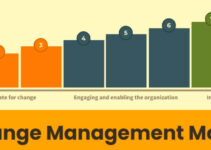Change management risk analysis plays a key role for businesses and companies to decrease the risk factor attached to the change initiative. It comprises analyzing potential change and observing how it would impact the organizational operations and operations. Today, we’ll discuss change management risk analysis; various types, tips for comprehending it, benefits, and steps involved in conducting change management risk assessment.
The outcome of change management risk analysis helps you to make effective and informed decisions for the execution and success of the change project. Well-structured processes allow businesses and companies to have stability during the transformation phase; helping them to efficiently achieve the results.
Types of Change Management Risks
- Confusion, disbelief, and uncertain about the positive outcome of the change project
- Lack of clarity about the need for change
- Improper and limited governance and change management framework
- Limited team members to complete the work
- Funds and financial limitations
- No guide and direction from the company’s leadership
- Low support from the partners, team members, and stakeholders
Tips to Comprehend the Change Management Risk
- Clearly outlining and defining the desired results from the change project
- Explaining the necessary elements to make sure successful change projects achieve the desired outcomes
- Recognizing the barriers and roadblocks that are stopping you from succeeding in the change project
- Establishing a failure-resistant and robust change management plan and strategic approach
Elements of Change Management Risks Analysis
Let’s discuss the key elements for the success of change management risk analysis; they’re as follows;
- Facilitating and supportive infrastructure like processes, systems, technologies, data, and governance
- Powerful leadership and management from the top of the company
- Comprehensive business model
- Strategic agenda of the company
Alignment among all these elements promotes positive belief and right behavior among employees, team members, and stakeholders in the organization. It helps the company to achieve its goals and objectives.
Benefits of Change Management Risk Analysis
Some of the main benefits of change management risk assessment are as follows;
- Improving flexibility in the company’s processes
- High efficiency and effectiveness
- Limited unexpected results
- Avoiding budget overruns, project delays, and expensive repair works
- Helps companies to develop customized strategies for the successful execution of the change project
- Make sure that the company achieves its goals and objectives under its budget
Conducting Change Management Risk Analysis
Let’s the main steps involved in conducting change management risk analysis; they’re as follows;
Outlining Risk Assessment Framework
First of all, you should clarify what the change project plans to achieve because it would impact the risk analysis framework and processes. This stage allows you to develop a clear change management risk assessment framework and comprehend the potential impact on the company. However, the risk assessment framework should be relevant to the change project and keep in mind the current change processes of the company.
It makes sure that all the stakeholders and team members recognize the risk factors associated with and objectives of the change project. As a result, it develops a clear comprehension of the steps they need to take to deal with the risk factors.
Data Analysis
Secondly, the process of performing change management assessment focuses on analyzing the data from multiple sources. It comprises gathering information and data from various sources like; interviews, reports, and documents of the stakeholders. It is significant to recognize the key elements of the change risk processes and analyze their impact.
However, the data analysis offers businesses and companies a key insight into the change risk process and its impact on the company’s operations. It helps companies in the following ways;
- Recognize the change risk involved
- Underlying causes for change and risks
- Analyzing the available solutions
- Making right and informed decisions while dealing with change
Recognizing & Analyzing Risks
Thirdly, your focus is on analyzing the identified and recognized change management risks. It comprises comprehending the underlying root causes and monitoring their impact on the company. They should recognize interdependencies, dependencies, and assumptions that would impact the results of the change risks assessment.
Companies should effectively analyze whether their current processes are sufficient to effectively deal with the change risks. It comprises of following;
- Analyzing the impact of the change project on systems, processes, and structures
- Comprehending the availability of resources to deal with the change risks
Creating Response Plan
Finally, the focus is on developing a technique and strategic approach to decrease the change risks; also developing a contingency plan in case the change plan doesn’t achieve success. This stage comprises recognizing the availability of necessary resources for the execution of the change project; technology or personal.
They should prioritize the change risks to ensure the effective management of the most critical change risks. It comprises of potential impact of every change risk on the company; knowing what risk to manage to decrease the impact.
Conclusion: Change Management Risk Analysis
After an in-depth study of the change management risk analysis; we have realized that change risk assessment helps companies to increase their growth and success. If you are learning about the change management risk assessment; then you should keep in mind the abovementioned elements, benefits, and steps involved in conducting risk assessment.
Ahsan is an accomplished researcher and has a deep insight in worldly life affairs. He goes Live 3 days a week on various social media platforms. Other than research writing, he’s a very interesting person.


